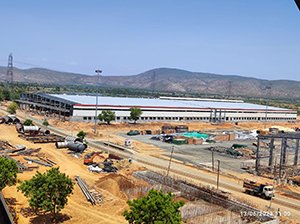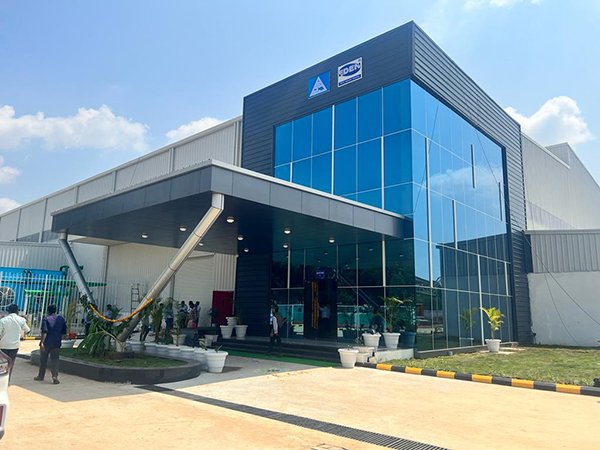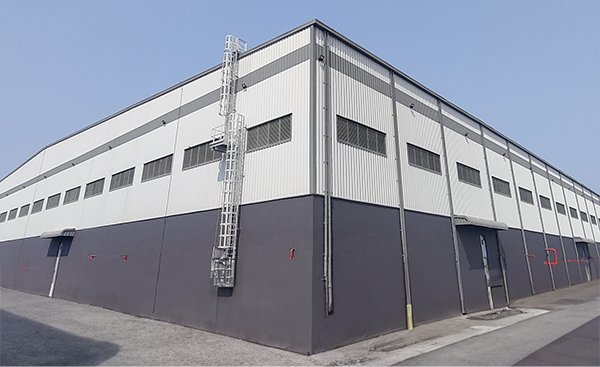Client: Century Ply Ltd.
Architecture & Structural Design:Sijcon Consultants Pvt Ltd.
Structural Consultant:Divya Consultants, Nagpur
PEB Contractor: Epack Prefab

Project Brief
Century Ply Ltd, a prominent player in the manufacturing industry, is set to redefine the landscape of the Kadapa district in Andhra Pradesh with its ambitious plan to construct two state-of-the-art manufacturing plants. The project encompasses two sprawling building structures, namely, the Medium Density Fiberboard (MDF) Plant and the High-Pressure Laminates (HPL) Plant, covering an expansive area of 44,898.81 square meters and 24,955.97 square meters, respectively.
The MDF plant measures 283.040 meters in length, 158.428 meters in width and boasts a clear height of 10 meters. The HPL plant measures 256.09 meters in length, 97.45 meters in width and boasts a clear height of 10.5 meters.
The MDF and HPL plants have a total tonnage of 2,251 MT and 1,299 MT, respectively. The design adheres to industry standards such as AISC-2010-LRFD, MBMA 2012, and IS1893-2016.
Geometry
The MDF plant stands out with its asymmetrical structure, featuring multiple gable frames, two transition frames, four jack beams, three lean-to areas, and two composite mezzanine floors, meticulously designed to accommodate functional requirements. Future expansion plans for the MDF structure include a 24 meters extension on one side.
In contrast, the HPL plant is a multi-span structure equipped with expansion capabilities on both sides, offering widths of 32 meters and 64 meters respectively. Additionally, the HPL plant boasts two jack beams, two lean-too areas, two composite mezzanine floors, and houses four 3 MT EOT cranes spanning a total length of 90 meters.
This project’s base elevation varies, such as, some columns’ base plates are 0.300 meters above FFL level while some columns’ base plates are 0.300 meters lower than FFL level due to project requirements. Both structures have a cable tray around the perimeter with various loadings, tier counts from two through four and widths ranging from 1meters to 1.5 meters. The cable tray’s critical width is 1.5 meters, while another cable tray is positioned along the width and is suspended from the roof with four tiers.

Structural Aspects
The structural design is centered around rigid frames and primary members. Built-up I sections are utilized for columns and rafters, while secondary members employ cold-form sections. Z-sections are employed for purlins and girts, while hot-rolled section is used for bracing and opening supporting structures. Primary and secondary elements maintain a minimum thickness of 5mm and 1.8mm respectively. The longitudinal stability of the buildings is ensured through a pipe brace system, employing X-braced bays in the roof and portal/X-braced bays in the walls.
Challenges & Solutions
The construction of these manufacturing plants presented a series of challenges that required ingenious solutions.
The end wall is one of the difficult aspects of an MDF structure. For aesthetic purposes, the end wall features a 3.5 m high fascia covered by the entire facade. HPL panels measuring 2.4 m × 1.2 m will be used for the facade, hence we have provided tube structures to support it on a 2.4 m x 1.2 m grid.
The presence of a 7 m x 27 m Mat former cutout within the MDF building demanded a 27 m long jack beam without a supporting column on one side. Creative engineering solutions were devised, supporting the jack beam using the rafter and the column.
Series of challenges of MDF building continues in terms of heights. As a result of the building’s asymmetry, height varies at various points, but the high bay lean-to area’s height is crucial. The high bay is 32 m.
Although HPL is a multi-span structure, the client wants to minimize some of the intermediate columns to better utilize the available area for the installation of machinery and equipment. We, therefore, designed two 30 m long jack portals.
Because there is a risk of overlap with variable numbers of cable tray tiers, we provide additional holes and loose brackets.
The building’s eaves are curved since we didn’t provide gutters or downspouts for the roof because of the possibility of choking during production. Standing seam panels are used in conjunction with curved eave sheeting.

Uniqueness
Innovative architectural decisions enhance the functionality and aesthetics of the buildings. Standing seam roofing material was selected for its durability and zero chances of leakage. Ventilation is achieved through the strategic implementation of roof monitors and louvers, with the MDF plant boasting two roof monitors and the HPL plant featuring one. Polycarbonate sheets were employed for the roof and walls, diffusing ambient lighting within the structures. Furthermore, glass wool insulation was used in the roof and wall cladding, ensuring energy efficiency and optimal thermal control.
What truly sets this project apart is the comprehensive integration of every PEB structural element, leaving no stone unturned. From multi-gable frames, jack beams, mezzanine floors, and transition frames to cable trays, high bays, low bays, fascia, roof monitors, reverse canopies, and crane provisions, this project showcases the culmination of engineering excellence. The combination of innovative design choices, meticulous planning, and expert execution makes Century Ply Ltd. manufacturing plants in Kadapa a testament to the company’s commitment to technological advancements and architectural finesse.


Software Used
STAAD.Pro and CONNECT Edition have been used for drawing up the plan, sketches, 3D model, etc.
In Conclusion
Century Ply Ltd.’s visionary endeavor to construct two manufacturing plants in the Kadapa district of Andhra Pradesh exemplifies its dedication to pushing the boundaries of structural design and engineering. Through their collaboration with the stakeholders, they have brought to life two remarkable structures that seamlessly integrate form and functionality. This project serves as a testament to the limitless possibilities of modern construction, setting new standards for the industry and inspiring future ventures.







I was studying some of your posts on this site and I conceive this site is really informative!
Continue putting up.Blog monry